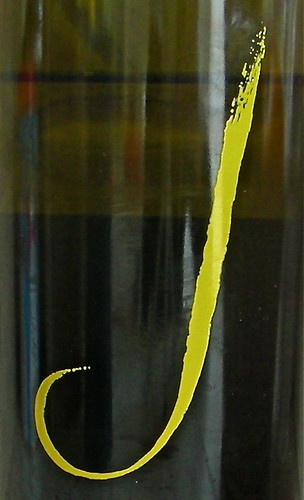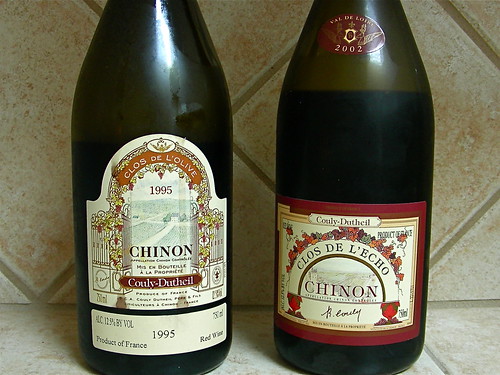From time to time, we get together with three other couples for a blind wine tasting party. These parties are always a lot of fun and easy to organize. The hosting couple cooks while the rest of the group brings bottles according to a chosen theme. Before the tasting, we hide the bottles in homemade purple velvet bags and randomly pin letters to them so that nobody can guess their identity. At the end of the dinner, the wines are ranked and then unveiled, with sometimes some surprising results!
The theme of our last gathering was Pinot Noir from
Los Carneros and
Anderson Valley, two of California's coolest wine regions and well renowned for their Pinot Noirs. Here are the wines that we tasted:

•
2004 Ancien Pinot Noir Mink Vineyard Napa Valley:
Ancien Wines is a winery dedicated to Burgundian varietals that produces small lots of Pinot Noir and Chardonnay. Mink Vineyard is actually not in Carneros but in Napa, an appellation better known for Cabernet than Pinot. But according to the winery's release notes, the climate in this relatively unknown area east of the city of Napa is similar to Carneros and the soil is unique — made up of a rocky/cobbly alluvial with underlying volcanic tufa. Our notes: dark color, sweet nose of cherry, strawberry, vanilla, and herbs. On the palate, liquorish, spicy, with some acidity. Medium finish. Overall, we enjoyed the wine and ranked it third with 15 points.
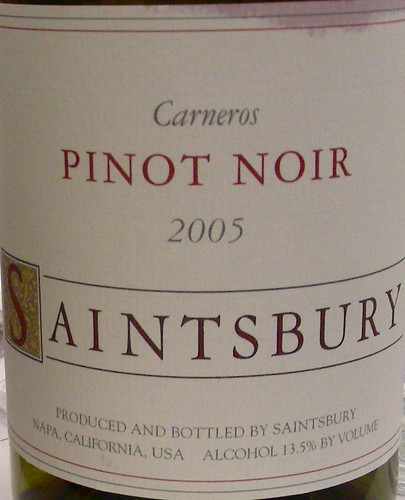
•
2005 Saintsbury Pinot Noir Los Carneros:
Saintsbury Vineyard is a California Pinot Noir pioneer. With the release in 1981 of 2000 cases of Carneros Pinot Noir, the winery's mission has been to demonstrate that world-class Pinot Noir could made in California, especially in the Carneros District. Because it is bordered by the San Pablo Bay at the Southernmost end of the Napa and Sonoma valleys, Los Carneros is much cooler than the rest of Napa and Sonoma. In terms of wine style, Saintsbury emphasizes balance of tannin and acidity, as well as power and elegance without leaning toward the burnt jam style of Pinot that is sometimes found in California. Our notes: medium red, fresh cherry nose, notes of brown sugar, buttered toast, blueberry, and fig. One the palate, lively, earthy, smoky, Burgundian with a good mineral finish. The wine was everybody's favorite and came first with 10 points.
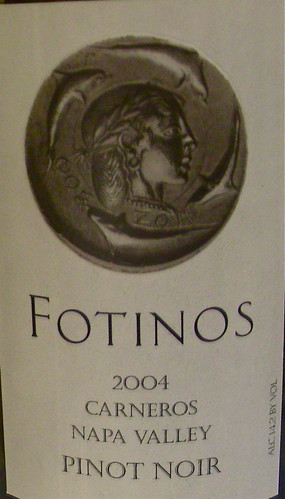
•
2004 Fotinos Pinot Noir Los Carneros: founded by a Greek family,
Fotinos Vineyards is located in the heart of the Carneros District of Napa Valley. Since 1969, it is dedicated to growing Pinot Noir grapes exclusively. The greek coin on the label dates back to 480 B.C. with an engraving of Artemis, the twin sister of Apollo and the Greek goddess of the forests and the moon. For the Fotinos family, she represents the beauty of nature. Our notes: medium color, nose a bit closed with notes of fresh cherries. On the palate, young, some acidity, a bit green, mineral, hints of sardines, tannins on the finish. We gave 18 points to this wine, which finished in fifth position.
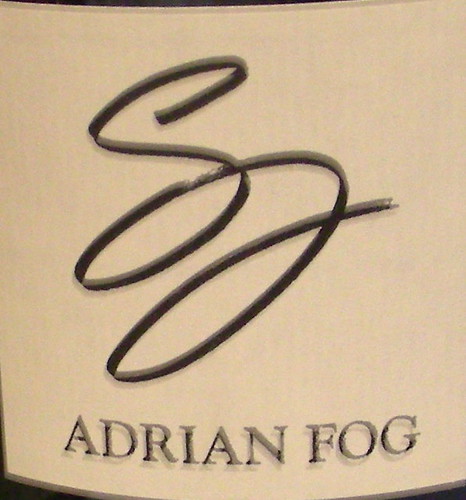
•
2005 Adrian Fog Pinot Noir Savoy Vineyard Anderson Valley:
Adrian Fog is an exclusive producer of single vineyard Pinot Noir. It selects vineyards based on their cool climate, orientation to the sun, clonal differences, and age of the vines. Clones and blocks are picked, fermented, and aged separately. Picking, racking, and bottling are scheduled as close to the night of the full moon as possible and the winery recommends to drink Adrian Fog wine on the night of a full moon to enjoy it's full seductive essence. Unfortunately, maybe the night of our tasting was only a new moon, maybe the bottle was flawed for some reason, but we didn't like it at all. Our notes: dark color a bit cloudy, subdued, herbal nose. On the palate, acidic, green notes of cucumber pickles and sand gravel. The wine got 30 points, which placed it far behind the others.
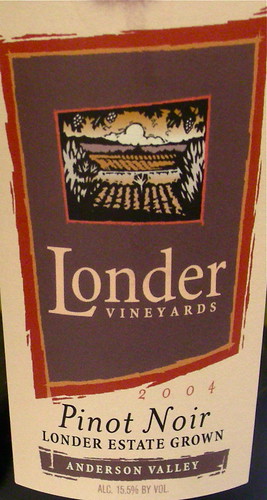
•
2004 Londer Estate Grown Pinot Noir Anderson Valley:
Londer Vineyards is located in the southwestern corner of Mendocino County, one of California's coolest areas. Adjacent to the Pacific Ocean, the vineyards are covered with a blanket of fog most summer nights. Then later during the day, the fog burns off and it becomes sunny and dry. With these conditions, the grapes slowly develop and ripen, which is ideal for growing varietals such as Pinot Noir, Gewurztraminer, and Chardonnay. The winery has 15 acres of Pinot Noir and an acre of Gewurztraminer mostly on south facing hills. Our notes: dark color, sweet fruity nose with notes of vanilla and burnt sugar. On the palate, some tasters found it nicely balanced, while for others it was tannic, alcoholic, aggressive. The wine finished in fourth place with 16 points.
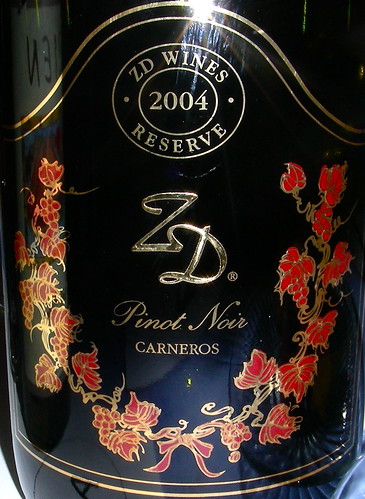
•
2004 ZD Reserve Pinot Noir Los Carneros: founded in 1969,
ZD Wines is owned by the deLeuze family. The ZD style is to craft rich, flavorful wines that reflect the varietal character of the grape. This wine comes from ZD's own deLeuze Family Vineyard in Los Carneros. The vineyard is dry farmed and has been farmed organically since 1996. It was officially certified in 1999. Prior to its release, the wine was aged for 15 months in small French oak barrels with minimal racking. Our notes: dark color, fragrant nose of sweet currant, notes of caramel, chocolate and clove. On the palate, rich, full-bodied, although not too pinot-ish, medium finish. Overall, the wine was very well received and was placed in second position with 12 points.
Previous blind tastings:
•
Blind Tasting of Grenache-based wines•
Chardonnay Blind Tasting•
Pinot Noir Blind TastingTechnorati tags: wine food & drink
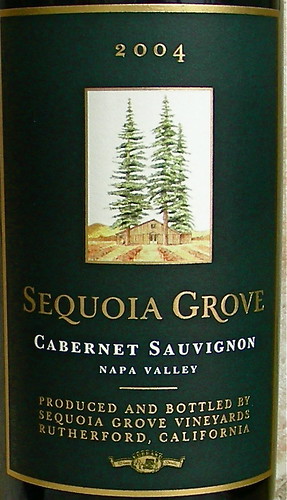 This bottle was sent to me by the Kobrand Corporation, the wine and spirit importer and distributor. When I received it, I became curious about the wine as I realized that I had never visited the Sequoia Grove winery, although it is right on Highway 29, just 1 mile north of Rutherford.
This bottle was sent to me by the Kobrand Corporation, the wine and spirit importer and distributor. When I received it, I became curious about the wine as I realized that I had never visited the Sequoia Grove winery, although it is right on Highway 29, just 1 mile north of Rutherford.